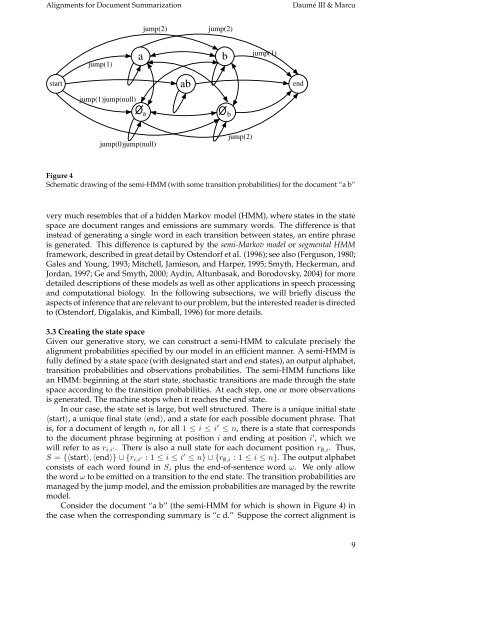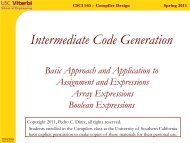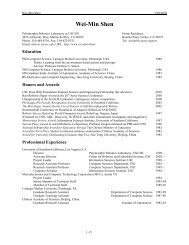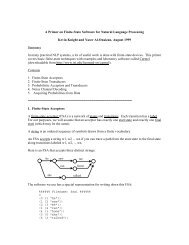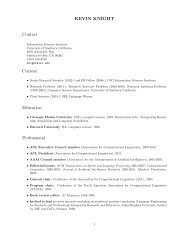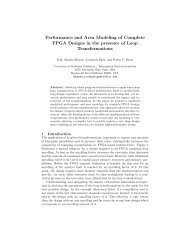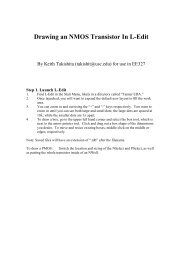Induction of Word and Phrase Alignments for Automatic Document ...
Induction of Word and Phrase Alignments for Automatic Document ...
Induction of Word and Phrase Alignments for Automatic Document ...
Create successful ePaper yourself
Turn your PDF publications into a flip-book with our unique Google optimized e-Paper software.
<strong>Alignments</strong> <strong>for</strong> <strong>Document</strong> Summarization Daumé III & Marcu<br />
jump(1)<br />
a b<br />
start end<br />
jump(1)jump(null)<br />
jump(2)<br />
jump(0)jump(null)<br />
ab<br />
jump(2)<br />
a b<br />
jump(2)<br />
jump(1)<br />
Figure 4<br />
Schematic drawing <strong>of</strong> the semi-HMM (with some transition probabilities) <strong>for</strong> the document “a b”<br />
very much resembles that <strong>of</strong> a hidden Markov model (HMM), where states in the state<br />
space are document ranges <strong>and</strong> emissions are summary words. The difference is that<br />
instead <strong>of</strong> generating a single word in each transition between states, an entire phrase<br />
is generated. This difference is captured by the semi-Markov model or segmental HMM<br />
framework, described in great detail by Ostendorf et al. (1996); see also (Ferguson, 1980;<br />
Gales <strong>and</strong> Young, 1993; Mitchell, Jamieson, <strong>and</strong> Harper, 1995; Smyth, Heckerman, <strong>and</strong><br />
Jordan, 1997; Ge <strong>and</strong> Smyth, 2000; Aydin, Altunbasak, <strong>and</strong> Borodovsky, 2004) <strong>for</strong> more<br />
detailed descriptions <strong>of</strong> these models as well as other applications in speech processing<br />
<strong>and</strong> computational biology. In the following subsections, we will briefly discuss the<br />
aspects <strong>of</strong> inference that are relevant to our problem, but the interested reader is directed<br />
to (Ostendorf, Digalakis, <strong>and</strong> Kimball, 1996) <strong>for</strong> more details.<br />
3.3 Creating the state space<br />
Given our generative story, we can construct a semi-HMM to calculate precisely the<br />
alignment probabilities specified by our model in an efficient manner. A semi-HMM is<br />
fully defined by a state space (with designated start <strong>and</strong> end states), an output alphabet,<br />
transition probabilities <strong>and</strong> observations probabilities. The semi-HMM functions like<br />
an HMM: beginning at the start state, stochastic transitions are made through the state<br />
space according to the transition probabilities. At each step, one or more observations<br />
is generated. The machine stops when it reaches the end state.<br />
In our case, the state set is large, but well structured. There is a unique initial state<br />
〈start〉, a unique final state 〈end〉, <strong>and</strong> a state <strong>for</strong> each possible document phrase. That<br />
is, <strong>for</strong> a document <strong>of</strong> length n, <strong>for</strong> all 1 ≤ i ≤ i ′ ≤ n, there is a state that corresponds<br />
to the document phrase beginning at position i <strong>and</strong> ending at position i ′ , which we<br />
will refer to as ri,i ′. There is also a null state <strong>for</strong> each document position r ∅,i. Thus,<br />
S = {〈start〉, 〈end〉} ∪ {ri,i ′ : 1 ≤ i ≤ i′ ≤ n} ∪ {r ∅,i : 1 ≤ i ≤ n}. The output alphabet<br />
consists <strong>of</strong> each word found in S, plus the end-<strong>of</strong>-sentence word ω. We only allow<br />
the word ω to be emitted on a transition to the end state. The transition probabilities are<br />
managed by the jump model, <strong>and</strong> the emission probabilities are managed by the rewrite<br />
model.<br />
Consider the document “a b” (the semi-HMM <strong>for</strong> which is shown in Figure 4) in<br />
the case when the corresponding summary is “c d.” Suppose the correct alignment is<br />
9


